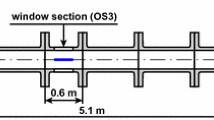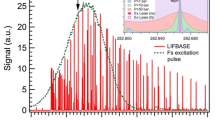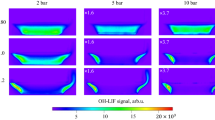2
H2O2). Laser-induced fluorescence spectra from glyoxal vapor using the same excitation wavelength of 428 nm showed the same strongest lines as the signal from the flame. Glyoxal was visualized in two different modes; two-dimensional imaging and a spatial-spectral mode where spectra were obtained at different spatial positions in the flame simultaneously. For the premixed laminar rich flame it is shown that glyoxal is produced early in the flame, before the signals for C2 and CH appear. For the turbulent non-premixed flames it is shown that glyoxal is produced in a layer on the fuel rich side of the flames. Here the fuel is premixed with ambient air. This layer is thin and has a high spatial resolution.
The general trend was that the glyoxal signal appeared in regions with a lower temperature compared with the emission from C2 and CH. The imaging of glyoxal in turbulent acetylene flames is a promising tool for achieving new insight into flame phenomena, as it gives very good structural information on the flame front. Tests so far do not indicate that the detected glyoxal is a result of photo-production. To our knowledge, this is the first detection of glyoxal in flames using laser-induced fluorescence.
Similar content being viewed by others
Author information
Authors and Affiliations
Additional information
Received: 19 December 1996/Revised version: 26 May 1997
Rights and permissions
About this article
Cite this article
Tichy, F., Bjorge, T., Magnussen, B. et al. Two-dimensional imaging of glyoxal (C2H2O2) in acetylene flames using laser-induced fluorescence . Appl Phys B 66, 115–119 (1998). https://doi.org/10.1007/s003400050364
Issue Date:
DOI: https://doi.org/10.1007/s003400050364




